Application of Spectrally Derived Soil Type as Ancillary Data to Improve the Estimation of Soil Organic Carbon by Using the Chinese Soil Vis-NIR Spectral Library
Abstract
1. Introduction
2. Materials and Methods
2.1. Sample Collection
2.2. Spectral Measurement and Chemical Analysis
2.3. Model Calibration and Validation
2.3.1. Model Calibration
2.3.2. Model Validation
3. Result
3.1. Descriptive Statistics
3.2. Discriminating Soil Type through Vis-NIR Spectroscopy
3.3. Estimation Accuracy of SOC Models Using Different Stratification Strategies
4. Discussion
4.1. Soil Type Prediction through Vis-NIR Spectroscopy
4.2. Effects of Stratifying Samples by Soil Type in SOC Estimation (Strategies II and III)
4.3. Effects of Spectrally Derived Soil Type on SOC Estimation
5. Conclusions
Supplementary Materials
Author Contributions
Funding
Acknowledgments
Conflicts of Interest
References
- Lal, R. Soil carbon sequestration impacts on global climate change and food security. Science 2004, 304, 1623–1627. [Google Scholar] [CrossRef] [PubMed]
- Lehmann, J.; Kleber, M. The contentious nature of soil organic matter. Nature 2015, 528, 60–68. [Google Scholar] [CrossRef] [PubMed]
- Li, S.; Shi, Z.; Chen, S.; Ji, W.; Zhou, L.; Yu, W.; Webster, R. In situ measurements of organic carbon in soil profiles using vis-nir spectroscopy on the qinghai–tibet plateau. Environ. Sci. Technol. 2015, 49, 4980–4987. [Google Scholar] [CrossRef] [PubMed]
- Nocita, M.; Stevens, A.; Toth, G.; Panagos, P.; van Wesemael, B.; Montanarella, L. Prediction of soil organic carbon content by diffuse reflectance spectroscopy using a local partial least square regression approach. Soil Biol. Biochem. 2014, 68, 337–347. [Google Scholar] [CrossRef]
- Wu, H.B.; Guo, Z.T.; Peng, C.H. Land use induced changes of organic carbon storage in soils of china. Glob. Chang. Boil. 2003, 9, 305–315. [Google Scholar] [CrossRef]
- Bellon-Maurel, V.; McBratney, A. Near-infrared (nir) and mid-infrared (MIR) spectroscopic techniques for assessing the amount of carbon stock in soils–critical review and research perspectives. Soil Biol. Biochem. 2011, 43, 1398–1410. [Google Scholar] [CrossRef]
- Walkley, A.; Black, I.A. An examination of the degtjareff method for determining soil organic matter, and a proposed modification of the chromic acid titration method. Soil Sci. 1934, 37, 29–38. [Google Scholar] [CrossRef]
- Nelson, D.; Sommers, L.E. Total carbon, organic carbon, and organic matter 1. Methods Soil Anal. Part 2 Chem. Microbiol. Prop. 1982, 539–579. [Google Scholar]
- Viscarra Rossel, R.A.; Hicks, W.S. Soil organic carbon and its fractions estimated by visible–near infrared transfer functions. Eur. J. Soil Sci. 2015, 66, 438–450. [Google Scholar] [CrossRef]
- Shi, Z.; Ji, W.; Viscarra Rossel, R.A.; Chen, S.; Zhou, Y. Prediction of soil organic matter using a spatially constrained local partial least squares regression and the chinese vis–nir spectral library. Eur. J. Soil Sci. 2015, 66, 679–687. [Google Scholar] [CrossRef]
- Kuang, B.; Mouazen, A.M. Influence of the number of samples on prediction error of visible and near infrared spectroscopy of selected soil properties at the farm scale. Eur. J. Soil Sci. 2012, 63, 421–429. [Google Scholar] [CrossRef]
- Viscarra Rossel, R.A.; Lobsey, C.R.; Sharman, C.; Flick, P.; McLachlan, G. Novel proximal sensing for monitoring soil organic c stocks and condition. Environ. Sci. Technol. 2017, 51, 5630–5641. [Google Scholar] [CrossRef] [PubMed]
- Paz-Kagan, T.; Zaady, E.; Salbach, C.; Schmidt, A.; Lausch, A.; Zacharias, S.; Notesco, G.; Ben-Dor, E.; Karnieli, A. Mapping the spectral soil quality index (ssqi) using airborne imaging spectroscopy. Remote. Sens. 2015, 7, 15748–15781. [Google Scholar] [CrossRef]
- Vasques, G.M.; Grunwald, S.; Harris, W.G. Spectroscopic models of soil organic carbon in florida, USA. J. Environ. Qual. 2010, 39, 923–934. [Google Scholar] [CrossRef] [PubMed]
- Ji, W.; Li, S.; Chen, S.; Shi, Z.; Viscarra Rossel, R.A.; Mouazen, A.M. Prediction of soil attributes using the chinese soil spectral library and standardized spectra recorded at field conditions. Soil Tillage Res. 2016, 155, 492–500. [Google Scholar] [CrossRef]
- Viscarra Rossel, R.A.; Behrens, T.; Ben-Dor, E.; Brown, D.; Demattê, J.; Shepherd, K.; Shi, Z.; Stenberg, B.; Stevens, A.; Adamchuk, V.; et al. A global spectral library to characterize the world’s soil. Earth-Sci. Rev. 2016, 155, 198–230. [Google Scholar] [CrossRef]
- Gogé, F.; Gomez, C.; Jolivet, C.; Joffre, R. Which strategy is best to predict soil properties of a local site from a national vis–nir database? Geoderma 2014, 213, 1–9. [Google Scholar] [CrossRef]
- Stevens, A.; Nocita, M.; Tóth, G.; Montanarella, L.; van Wesemael, B. Prediction of soil organic carbon at the european scale by visible and near infrared reflectance spectroscopy. PLoS ONE 2013, 8, e66409. [Google Scholar] [CrossRef] [PubMed]
- Brown, D.J.; Shepherd, K.D.; Walsh, M.G.; Mays, M.D.; Reinsch, T.G. Global soil characterization with vnir diffuse reflectance spectroscopy. Geoderma 2006, 132, 273–290. [Google Scholar] [CrossRef]
- Viscarra Rossel, R.A.; Behrens, T. Using data mining to model and interpret soil diffuse reflectance spectra. Geoderma 2010, 158, 46–54. [Google Scholar] [CrossRef]
- Ji, W.; Li, X.; Li, C.; Zhou, Y.; Shi, Z. Using different data mining algorithms to predict soil organic matter based on visible-near infrared spectroscopy. Spectrosc. Spectr. Anal. 2012, 32, 2393–2398. [Google Scholar]
- Gholizadeh, A.; Borůvka, L.; Saberioon, M.M.; Kozák, J.; Vašát, R.; Němeček, K. Comparing different data preprocessing methods for monitoring soil heavy metals based on soil spectral features. Soil Water Res. 2015, 10, 218–227. [Google Scholar] [CrossRef]
- Rammal, A.; Perrin, E.; Vrabie, V.; Bertrand, I.; Habrant, A.; Chabbert, B. Optimal preprocessing and FCM clustering of MIR, NIR and combined MIR-NIR spectra for classification of maize roots. In Proceedings of the 2014 Third International Conference on e-Technologies and Networks for Development (ICeND), Beirut, Lebanon, 29 April–1 May 2014; IEEE: Piscataway, NJ, USA, 2014; pp. 110–115. [Google Scholar]
- Gras, J.-P.; Barthès, B.G.; Mahaut, B.; Trupin, S. Best practices for obtaining and processing field visible and near infrared (VNIR) spectra of topsoils. Geoderma 2014, 214, 126–134. [Google Scholar] [CrossRef]
- Wang, X.; Chen, Y.; Guo, L.; Liu, L. Construction of the calibration set through multivariate analysis in visible and near-infrared prediction model for estimating soil organic matter. Remote Sens. 2017, 9, 201. [Google Scholar] [CrossRef]
- Igne, B.; Reeves, J.B.; McCarty, G.; Hively, W.D.; Lund, E.; Hurburgh, C.R. Evaluation of spectral pretreatments, partial least squares, least squares support vector machines and locally weighted regression for quantitative spectroscopic analysis of soils. J. Near Infrared Spectrosc. 2010, 18, 167–176. [Google Scholar] [CrossRef]
- Gogé, F.; Joffre, R.; Jolivet, C.; Ross, I.; Ranjard, L. Optimization criteria in sample selection step of local regression for quantitative analysis of large soil NIRS database. Chemom. Intell. Lab. Syst. 2012, 110, 168–176. [Google Scholar] [CrossRef]
- Cierniewski, J.; Kaźmierowski, C.; Kuśnierek, K.; Piekarczyk, J.; Kwlewicz, S.; Guliński, M.; Terelak, H.; Stuczyński, T.; Maliszewska-Kordybach, B. Unsupervised clustering of soil spectral curves to obtain their stronger correlation with soil properties. In Proceedings of the 2010 2nd Workshop on Hyperspectral Image and Signal Processing: Evolution in Remote Sensing (WHISPERS), Reykjavik, Iceland, 14–16 June 2010; IEEE: Piscataway, NJ, USA, 2010; pp. 1–4. [Google Scholar]
- Udelhoven, T.; Emmerling, C.; Jarmer, T. Quantitative analysis of soil chemical properties with diffuse reflectance spectrometry and partial least-square regression: A feasibility study. Plant Soil 2003, 251, 319–329. [Google Scholar] [CrossRef]
- Stevens, A.; Udelhoven, T.; Denis, A.; Tychon, B.; Lioy, R.; Hoffmann, L.; Van Wesemael, B. Measuring soil organic carbon in croplands at regional scale using airborne imaging spectroscopy. Geoderma 2010, 158, 32–45. [Google Scholar] [CrossRef]
- Peng, Y.; Knadel, M.; Gislum, R.; Deng, F.; Norgaard, T.; de Jonge, L.W.; Moldrup, P.; Greve, M.H. Predicting soil organic carbon at field scale using a national soil spectral library. J. Near Infrared Spectrosc. 2013, 21, 213–222. [Google Scholar] [CrossRef]
- McDowell, M.L.; Bruland, G.L.; Deenik, J.L.; Grunwald, S. Effects of subsetting by carbon content, soil order, and spectral classification on prediction of soil total carbon with diffuse reflectance spectroscopy. Appl. Environ. Soil Sci. 2012, 2012, 294121. [Google Scholar] [CrossRef]
- Madari, B.E.; Reeves, J.B., III; Coelho, M.R.; Machado, P.L.; De-Polli, H.; Coelho, R.M.; Benites, V.M.; Souza, L.F.; McCarty, G.W. Mid-and near-infrared spectroscopic determination of carbon in a diverse set of soils from the brazilian national soil collection. Spectrosc. Lett. 2005, 38, 721–740. [Google Scholar] [CrossRef]
- Brown, D.J. Using a global VNIR soil-spectral library for local soil characterization and landscape modeling in a 2nd-order uganda watershed. Geoderma 2007, 140, 444–453. [Google Scholar] [CrossRef]
- Guerrero, C.; Zornoza, R.; Gómez, I.; Mataix-Beneyto, J. Spiking of NIR regional models using samples from target sites: Effect of model size on prediction accuracy. Geoderma 2010, 158, 66–77. [Google Scholar] [CrossRef]
- Guerrero, C.; Stenberg, B.; Wetterlind, J.; Viscarra Rossel, R.A.; Maestre, F.; Mouazen, A.M.; Zornoza, R.; Ruiz-Sinoga, J.; Kuang, B. Assessment of soil organic carbon at local scale with spiked NIR calibrations: Effects of selection and extra-weighting on the spiking subset. Eur. J. Soil Sci. 2014, 65, 248–263. [Google Scholar] [CrossRef]
- Wetterlind, J.; Stenberg, B. Near-infrared spectroscopy for within-field soil characterization: Small local calibrations compared with national libraries spiked with local samples. Eur. J. Soil Sci. 2010, 61, 823–843. [Google Scholar] [CrossRef]
- Ogen, Y.; Neumann, C.; Chabrillat, S.; Goldshleger, N.; Ben Dor, E. Evaluating the detection limit of organic matter using point and imaging spectroscopy. Geoderma 2018, 321, 100–109. [Google Scholar] [CrossRef]
- Vasques, G.M.; Dematte, J.A.M.; Viscarra Rossel, R.A.; Ramirez-Lopez, L.; Terra, F.S. Soil classification using visible/near-infrared diffuse reflectance spectra from multiple depths. Geoderma 2014, 223, 73–78. [Google Scholar] [CrossRef]
- Viscarra Rossel, R.A.; Webster, R. Discrimination of australian soil horizons and classes from their visible–near infrared spectra. Eur. J. Soil Sci. 2011, 62, 637–647. [Google Scholar] [CrossRef]
- Shi, Z.; Wang, Q.; Peng, J.; Ji, W.; Liu, H.; Li, X.; Viscarra Rossel, R.A. Development of a national VNIR soil-spectral library for soil classification and prediction of organic matter concentrations. Sci. China Earth Sci. 2014, 57, 1671–1680. [Google Scholar] [CrossRef]
- Zhang, W.L.; Ai-Guo, X.U.; Zhang, R.L.; Hong, J.I. Review of soil classification and revision of china soil classification system. Sci. Agric. Sin. 2014, 47, 3214–3230. [Google Scholar]
- IUSS Working Group Wrb. World Reference Base for Soil Resources 2014 International Soil Classification System for Naming Soils and Creating Legends for Soil Maps; FAO: Rome, Italy, 2014. [Google Scholar]
- Liu, Y.; Jiang, Q.; Fei, T.; Wang, J.; Shi, T.; Guo, K.; Li, X.; Chen, Y. Transferability of a visible and near-infrared model for soil organic matter estimation in riparian landscapes. Remote Sens. 2014, 6, 4305–4322. [Google Scholar] [CrossRef]
- Zhang, J.; Xu, Z. Dye tracer infiltration technique to investigate macropore flow paths in maka mountain, yunnan province, china. J. Central South Univ. 2016, 23, 2101–2109. [Google Scholar] [CrossRef]
- Rozenstein, O.; Paz-Kagan, T.; Salbach, C.; Karnieli, A. Comparing the effect of preprocessing transformations on methods of land-use classification derived from spectral soil measurements. IEEE J. Sel. Top. Appl. Earth Obs. Remote Sens. 2015, 8, 2393–2404. [Google Scholar] [CrossRef]
- Debaene, G.; Niedzwiecki, J.; Pecio, A.; Zurek, A. Effect of the number of calibration samples on the prediction of several soil properties at the farm-scale. Geoderma 2014, 214, 114–125. [Google Scholar] [CrossRef]
- Steinier, J.; Termonia, Y.; Deltour, J. Smoothing and differentiation of data by simplified least square procedure. Anal. Chem. 1972, 44, 1906–1909. [Google Scholar] [CrossRef] [PubMed]
- Stenberg, B.; Viscarra Rossel, R.A.; Mouazen, A.M.; Wetterlind, J. Chapter five-visible and near infrared spectroscopy in soil science. Adv. Agron. 2010, 107, 163–215. [Google Scholar]
- Naes, T.; Martens, H. Multivariate Calibration; Norwegian Food Research Institute: Ås, Norway, 1989. [Google Scholar]
- Barnes, R.; Dhanoa, M.; Lister, S.J. Standard normal variate transformation and de-trending of near-infrared diffuse reflectance spectra. Appl. Spectrosc. 1989, 43, 772–777. [Google Scholar] [CrossRef]
- Moros, J.; Fdez-Ortiz, D.V.S.; Gredilla, A.; De, D.A.; Madariaga, J.M.; Garrigues, S.; De, L.G.M. Use of reflectance infrared spectroscopy for monitoring the metal content of the estuarine sediments of the nerbioi-ibaizabal river (metropolitan bilbao, bay of biscay, basque country). Environ. Sci. Technol. 2009, 43, 9314–9320. [Google Scholar] [CrossRef] [PubMed]
- Viscarra Rossel, R.A. Parles: Software for chemometric analysis of spectroscopic data. Chemom. Intell. Lab. Syst. 2008, 90, 72–83. [Google Scholar] [CrossRef]
- Echambadi, R.; Hess, J.D. Mean-centering does not alleviate collinearity problems in moderated multiple regression models. Mark. Sci. 2007, 26, 438–445. [Google Scholar] [CrossRef]
- Kuhn, M.; Johnson, K. Data pre-processing. Applied Predictive Modeling; Springer: Berlin, Germany, 2013; pp. 27–59. [Google Scholar]
- Li, Z.; Liu, J.; Shan, P.; Peng, S.; Lv, J.; Ma, Z. Strategy for constructing calibration sets based on a derivative spectra information space consensus. Chemom. Intell. Lab. Syst. 2016, 156, 7–13. [Google Scholar] [CrossRef]
- Goodarzi, M.; Sharma, S.; Ramon, H.; Saeys, W. Multivariate calibration of NIR spectroscopic sensors for continuous glucose monitoring. TrAC Trends Anal. Chem. 2015, 67, 147–158. [Google Scholar] [CrossRef]
- Della Riccia, G.; Del Zotto, S. A multivariate regression model for detection of fumonisins content in maize from near infrared spectra. Food Chem. 2013, 141, 4289–4294. [Google Scholar]
- Hazama, K.; Kano, M. Covariance-based locally weighted partial least squares for high-performance adaptive modeling. Chemom. Intell. Lab. Syst. 2015, 146, 55–62. [Google Scholar] [CrossRef]
- Minasny, B.; McBratney, A. Why you don’t need to use RPD. Pedometron 2013, 33, 14–15. [Google Scholar]
- Bellon-Maurel, V.; Fernandez-Ahumada, E.; Palagos, B.; Roger, J.-M.; McBratney, A. Critical review of chemometric indicators commonly used for assessing the quality of the prediction of soil attributes by NIR spectroscopy. TrAC Trends Anal. Chem. 2010, 29, 1073–1081. [Google Scholar] [CrossRef]
- Hong, Y.; Yu, L.; Chen, Y.; Liu, Y.; Liu, Y.; Liu, Y.; Cheng, H. Prediction of soil organic matter by VIS–NIR spectroscopy using normalized soil moisture index as a proxy of soil moisture. Remote Sens. 2017, 10, 28. [Google Scholar] [CrossRef]
- Szymańska, E.; Saccenti, E.; Smilde, A.K.; Westerhuis, J.A. Double-check: Validation of diagnostic statistics for PLS-DA models in metabolomics studies. Metabolomics 2012, 8, 3–16. [Google Scholar] [CrossRef] [PubMed]
- Li, L.; Xia, J.; Liu, L. Effect of purple soil organic matter on adsorption and desorption of Pb2+ by aggregates. Chin. J. Ecol. 2014, 33, 1274–1283. [Google Scholar]
- Liu, Y.; Pan, X.; Wang, C.; Li, Y.; Zhou, R.; Xie, X.; Wang, M. Prediction of coastal saline soil salinity based on VIS-NIR reflectance spectroscopy. Acta Pedofil Sin. 2012, 49, 824–829. [Google Scholar]
- Du, C.; Linker, R.; Shaviv, A. Identification of agricultural mediterranean soils using mid-infrared photoacoustic spectroscopy. Geoderma 2008, 143, 85–90. [Google Scholar] [CrossRef]
- Mouazen, A.M.; Karoui, R.; De Baerdemaeker, J.; Ramon, H. Classification of soil texture classes by using soil visual near infrared spectroscopy and factorial discriminant analysis techniques. J. Near Infrared Spectrosc. 2005, 13, 231–240. [Google Scholar] [CrossRef]
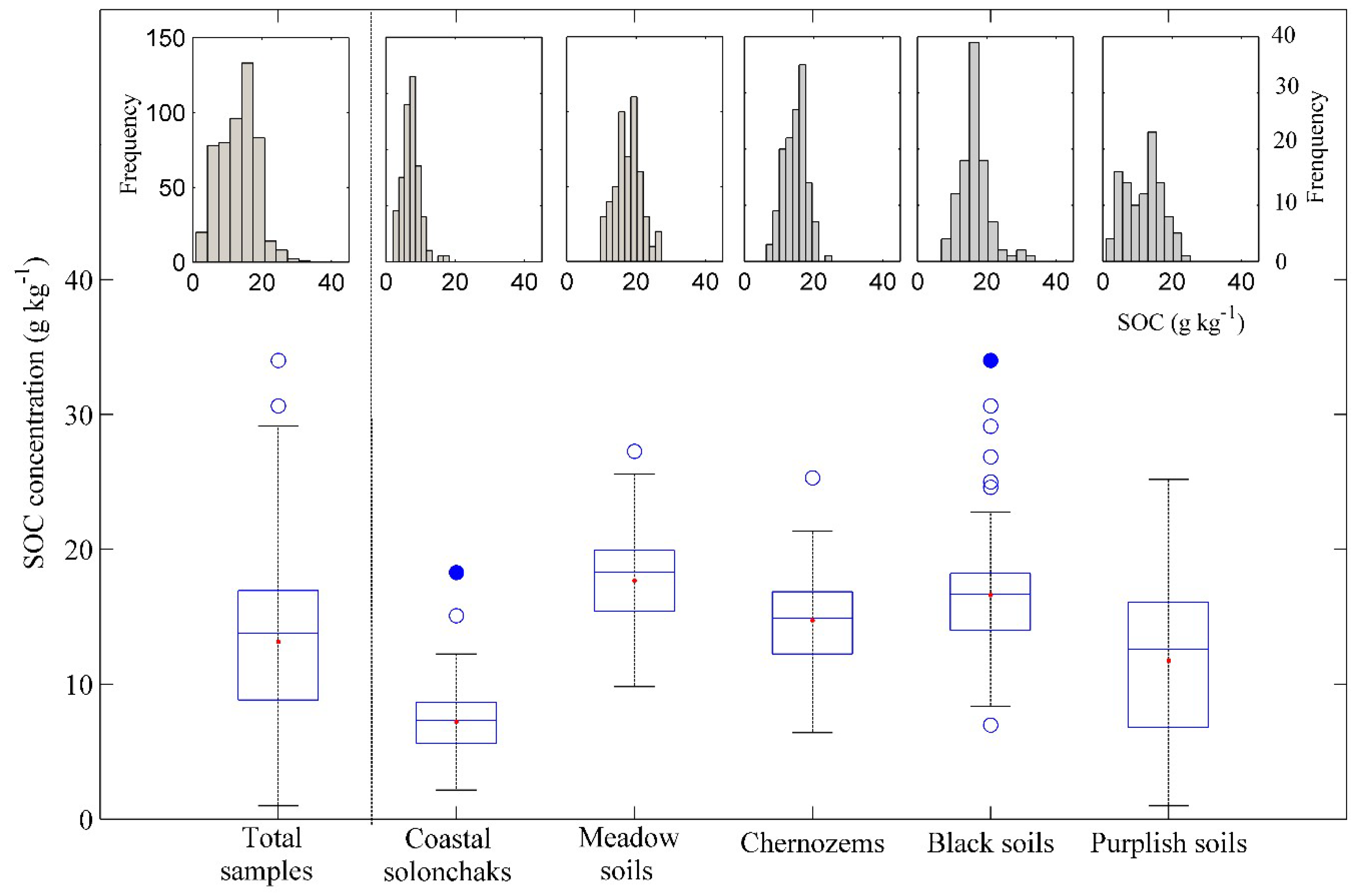
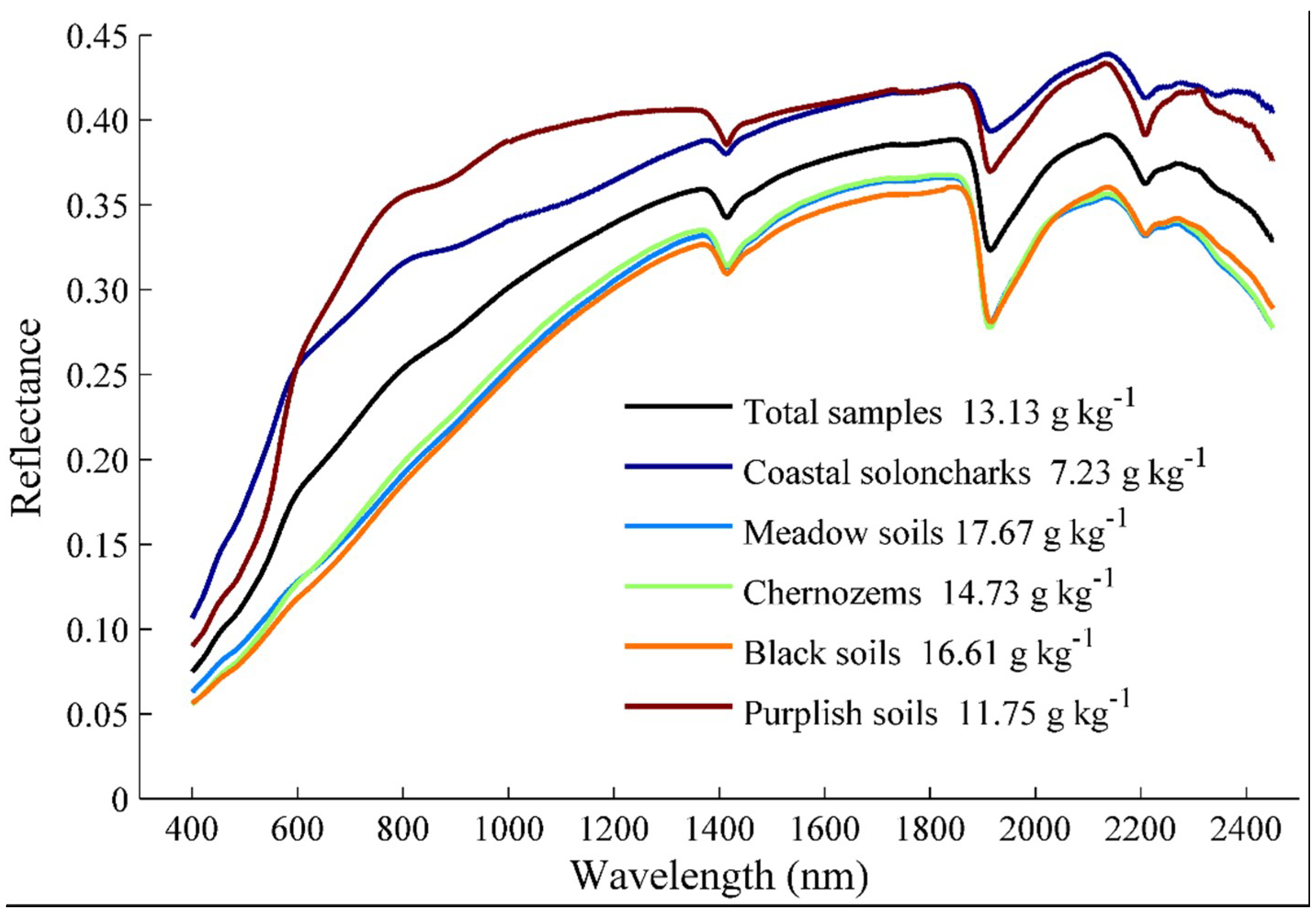

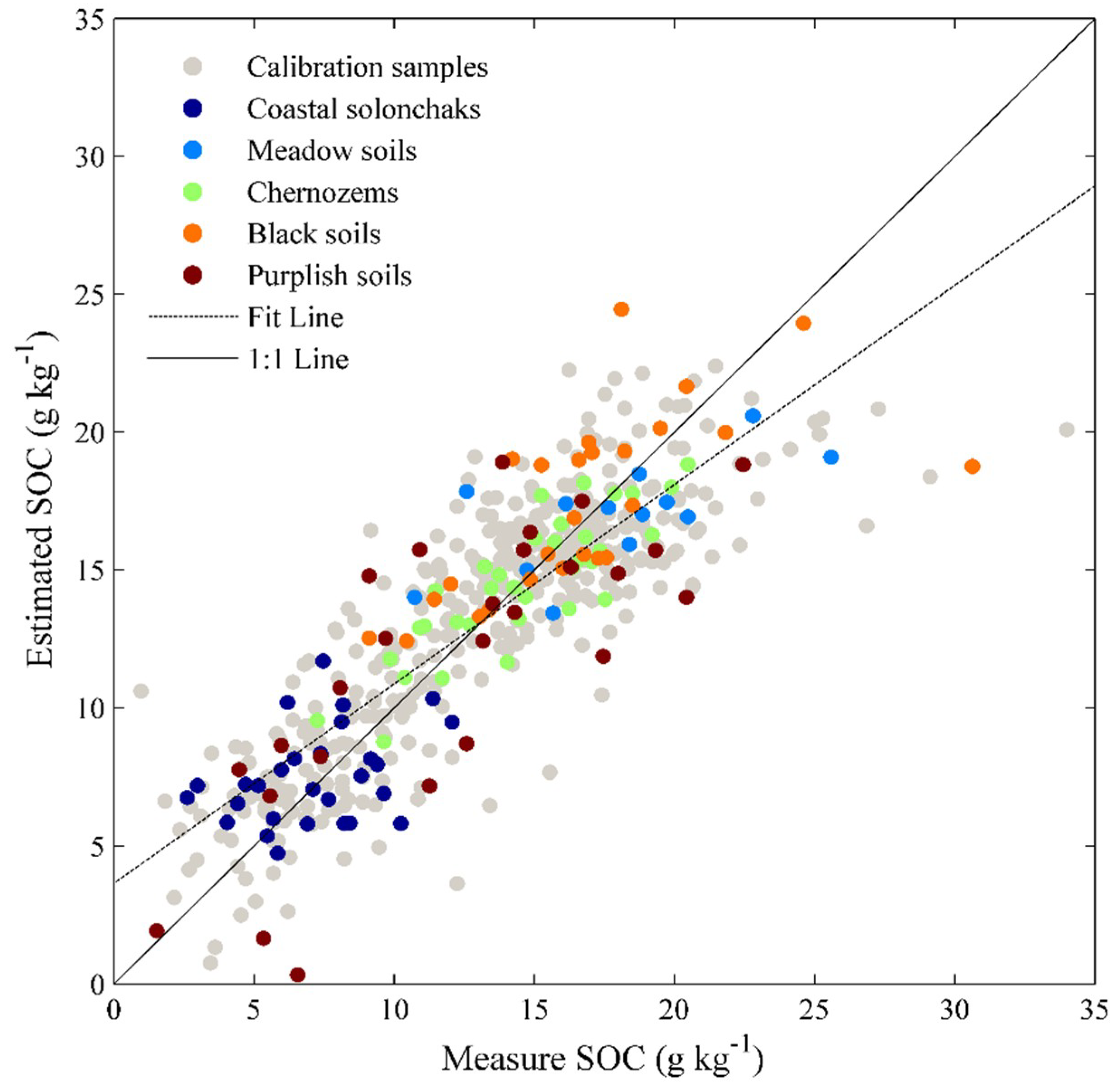
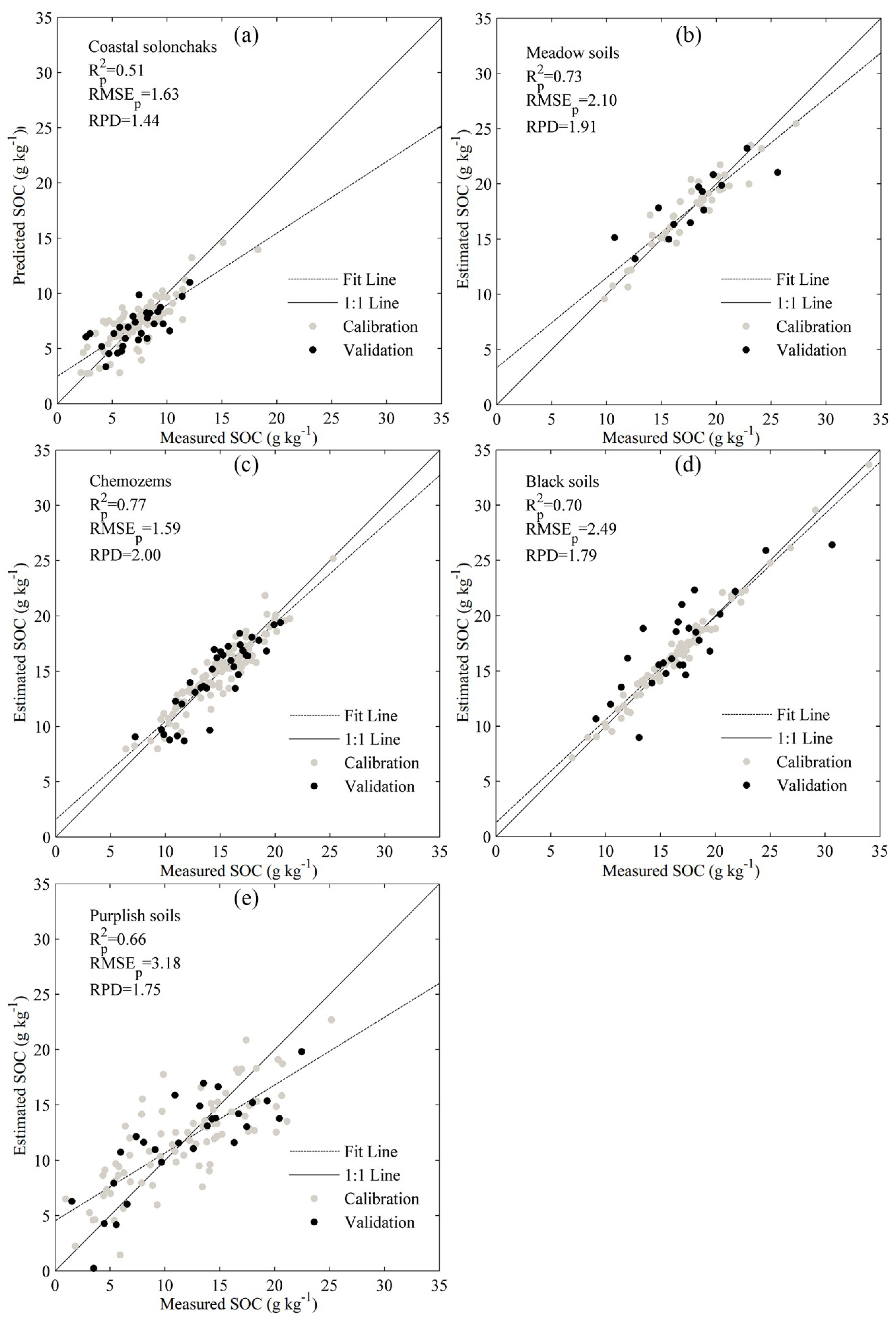
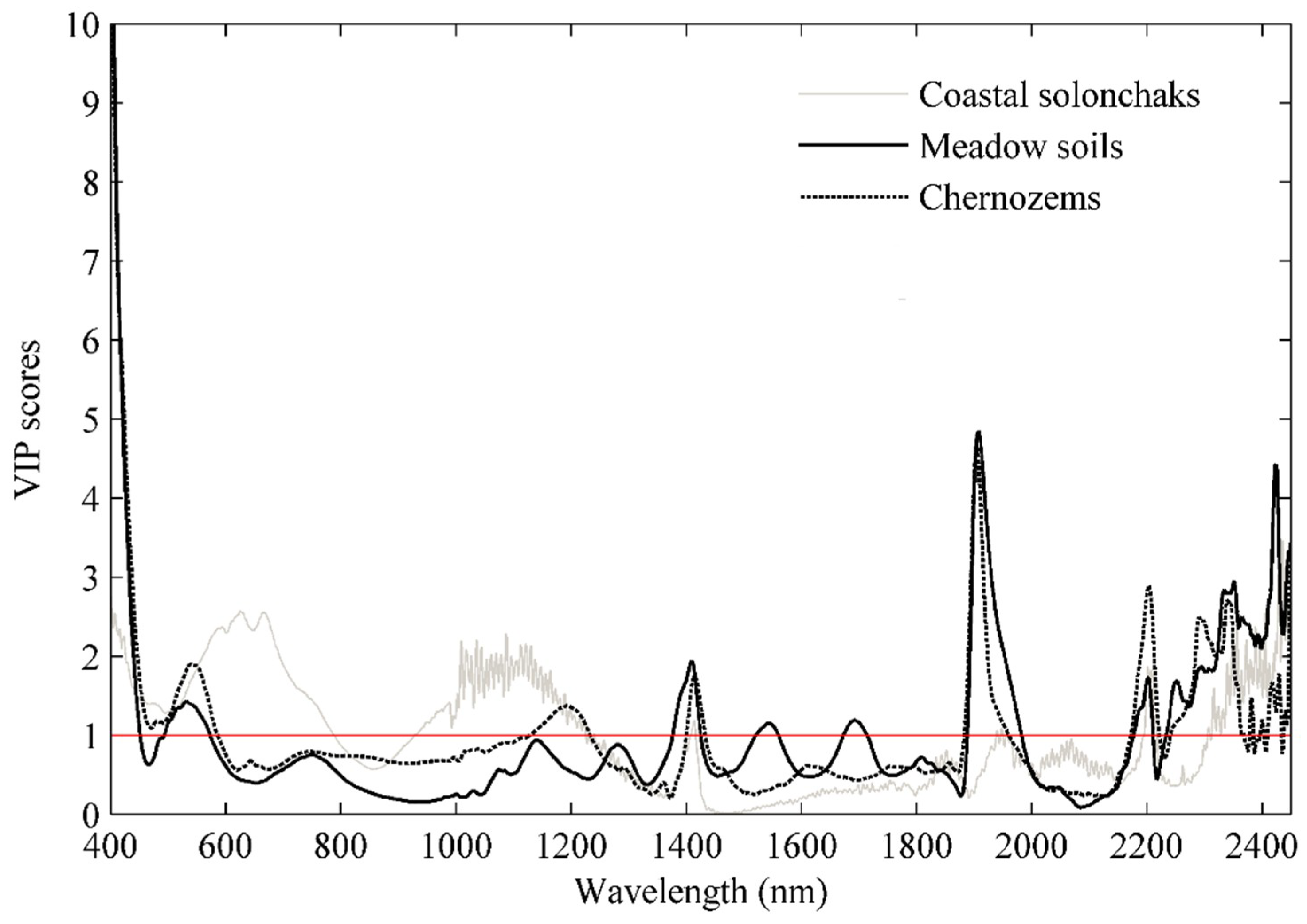
| Soil Type a | WRB b | Sample Set | Count | Min | Max | Mean | SD c | Skewness | Kurtosis | CV d |
|---|---|---|---|---|---|---|---|---|---|---|
| Coastal solonchaks | Solonchaks | All | 114 | 2.15 | 18.27 | 7.23 | 2.63 | 0.75 | 2.02 | 0.36 |
| Calibration | 86 | 2.15 | 18.27 | 7.26 | 2.72 | 0.87 | 2.32 | 0.37 | ||
| Validation | 28 | 2.61 | 12.06 | 7.13 | 2.35 | 0.07 | −0.45 | 0.33 | ||
| Meadow soils | Cambisols | All | 52 | 9.80 | 27.26 | 17.67 | 3.78 | 0.08 | −0.03 | 0.21 |
| Calibration | 39 | 9.80 | 27.26 | 17.61 | 3.75 | 0.07 | 0.07 | 0.21 | ||
| Validation | 13 | 10.73 | 25.58 | 17.85 | 4.01 | 0.08 | −0.3 | 0.22 | ||
| Chernozems | Chernozems | All | 138 | 6.38 | 25.29 | 14.73 | 3.27 | −0.02 | −0.02 | 0.22 |
| Calibration | 104 | 6.38 | 25.29 | 14.76 | 3.31 | 0.04 | 0.09 | 0.22 | ||
| Validation | 34 | 7.25 | 20.48 | 14.64 | 3.17 | −0.26 | −0.54 | 0.22 | ||
| Black soils | Phaeozems | All | 104 | 6.96 | 33.99 | 16.61 | 4.38 | 1.01 | 2.68 | 0.26 |
| Calibration | 78 | 6.96 | 33.99 | 16.57 | 4.38 | 0.99 | 2.88 | 0.26 | ||
| Validation | 26 | 9.11 | 30.63 | 16.75 | 4.46 | 1.05 | 2.09 | 0.27 | ||
| Purplish soils | Cambisols | All | 107 | 0.96 | 25.17 | 11.75 | 5.44 | 0.05 | −0.86 | 0.46 |
| Calibration | 80 | 0.96 | 25.17 | 11.76 | 5.44 | 0.06 | −0.83 | 0.46 | ||
| Validation | 27 | 1.52 | 22.45 | 11.73 | 5.57 | 0.02 | −0.94 | 0.48 | ||
| Total | All | 515 | 0.96 | 33.99 | 13.13 | 5.39 | 0.1 | −0.17 | 0.41 | |
| Calibration | 387 | 0.96 | 33.99 | 13.12 | 5.38 | 0.1 | −0.15 | 0.41 | ||
| Validation | 128 | 1.52 | 30.63 | 13.14 | 5.44 | 0.11 | −0.21 | 0.41 | ||
| Actual Soil Order | Agreement Rate (%) | |||||||
|---|---|---|---|---|---|---|---|---|
| Coastal Solonchaks | Meadow Soils | Chernozems | Black Soils | Purplish Soils | ||||
| Predicted soil type | Calibration set | Coastal solonchaks | 84 | 0 | 0 | 0 | 0 | 97.67 |
| Meadow soils | 0 | 29 | 9 | 5 | 1 | 74.36 | ||
| Chernozems | 0 | 10 | 94 | 10 | 0 | 90.38 | ||
| Black soils | 0 | 0 | 1 | 63 | 1 | 80.77 | ||
| Purplish soils | 2 | 0 | 0 | 0 | 78 | 97.50 | ||
| Overall agreement rate (%) | 89.92 | |||||||
| Validation set | Coastal solonchaks | 28 | 0 | 0 | 0 | 0 | 100.00 | |
| Meadow soils | 0 | 8 | 6 | 1 | 0 | 61.54 | ||
| Chernozems | 0 | 4 | 27 | 4 | 0 | 79.41 | ||
| Black soils | 0 | 1 | 1 | 21 | 0 | 80.77 | ||
| Purplish soils | 0 | 0 | 0 | 0 | 27 | 100.00 | ||
| Overall agreement rate (%) | 86.72 | |||||||
| Soil Type | Calibration | Validation | LVs | ||||
|---|---|---|---|---|---|---|---|
| SD | RMSEP | RPD | |||||
| Entire dataset (not stratified) | |||||||
| Coastal solonchaks | 0.48 | 2.01 | 1.73 | 0.12 | 2.38 | 0.99 | 12 |
| Meadow soils | 0.37 | 3.01 | 2.02 | 0.47 | 3.03 | 1.32 | 12 |
| Chernozems | 0.41 | 2.53 | 2.48 | 0.72 | 1.66 | 1.91 | 12 |
| Black soils | 0.17 | 4.06 | 3.34 | 0.46 | 3.28 | 1.36 | 12 |
| Purplish soils | 0.37 | 4.59 | 5.75 | 0.63 | 3.66 | 1.52 | 12 |
| Overall | 0.62 | 3.35 | 4.99 | 0.74 | 2.80 | 1.94 | 12 |
| Stratified by soil type | Stratified by soil type | ||||||
| Coastal solonchaks | 0.56 | 1.80 | 1.76 | 0.51 | 1.63 | 1.44 | 3 |
| Meadow soils | 0.67 | 2.18 | 2.86 | 0.73 | 2.10 | 1.91 | 7 |
| Chernozems | 0.73 | 1.73 | 3.29 | 0.77 | 1.59 | 2.00 | 11 |
| Black soils | 0.43 | 3.40 | 4.18 | 0.70 | 2.49 | 1.79 | 16 |
| Purplish soils | 0.53 | 3.70 | 4.46 | 0.66 | 3.18 | 1.75 | 4 |
| Overall | 0.75 | 2.27 | 5.22 | 0.83 | 2.26 | 2.41 | - |
| Stratified by soil type | Stratified by spectra-derived soil type | ||||||
| Coastal solonchaks | 0.56 | 1.80 | 1.76 | 0.51 | 1.63 | 1.44 | 3 |
| Meadow soils | 0.67 | 2.18 | 2.47 | 0.67 | 2.37 | 1.69 | 7 |
| Chernozems | 0.73 | 1.73 | 3.17 | 0.73 | 1.71 | 1.85 | 11 |
| Black soils | 0.43 | 3.40 | 4.45 | 0.72 | 2.45 | 1.82 | 16 |
| Purplish soils | 0.53 | 3.70 | 4.46 | 0.66 | 3.18 | 1.75 | 4 |
| Overall | 0.75 | 2.27 | 5.22 | 0.82 | 2.30 | 2.37 | - |
© 2018 by the authors. Licensee MDPI, Basel, Switzerland. This article is an open access article distributed under the terms and conditions of the Creative Commons Attribution (CC BY) license (http://creativecommons.org/licenses/by/4.0/).
Share and Cite
Liu, Y.; Shi, Z.; Zhang, G.; Chen, Y.; Li, S.; Hong, Y.; Shi, T.; Wang, J.; Liu, Y. Application of Spectrally Derived Soil Type as Ancillary Data to Improve the Estimation of Soil Organic Carbon by Using the Chinese Soil Vis-NIR Spectral Library. Remote Sens. 2018, 10, 1747. https://doi.org/10.3390/rs10111747
Liu Y, Shi Z, Zhang G, Chen Y, Li S, Hong Y, Shi T, Wang J, Liu Y. Application of Spectrally Derived Soil Type as Ancillary Data to Improve the Estimation of Soil Organic Carbon by Using the Chinese Soil Vis-NIR Spectral Library. Remote Sensing. 2018; 10(11):1747. https://doi.org/10.3390/rs10111747
Chicago/Turabian StyleLiu, Yi, Zhou Shi, Ganlin Zhang, Yiyun Chen, Shuo Li, Yongshen Hong, Tiezhu Shi, Junjie Wang, and Yaolin Liu. 2018. "Application of Spectrally Derived Soil Type as Ancillary Data to Improve the Estimation of Soil Organic Carbon by Using the Chinese Soil Vis-NIR Spectral Library" Remote Sensing 10, no. 11: 1747. https://doi.org/10.3390/rs10111747
APA StyleLiu, Y., Shi, Z., Zhang, G., Chen, Y., Li, S., Hong, Y., Shi, T., Wang, J., & Liu, Y. (2018). Application of Spectrally Derived Soil Type as Ancillary Data to Improve the Estimation of Soil Organic Carbon by Using the Chinese Soil Vis-NIR Spectral Library. Remote Sensing, 10(11), 1747. https://doi.org/10.3390/rs10111747









